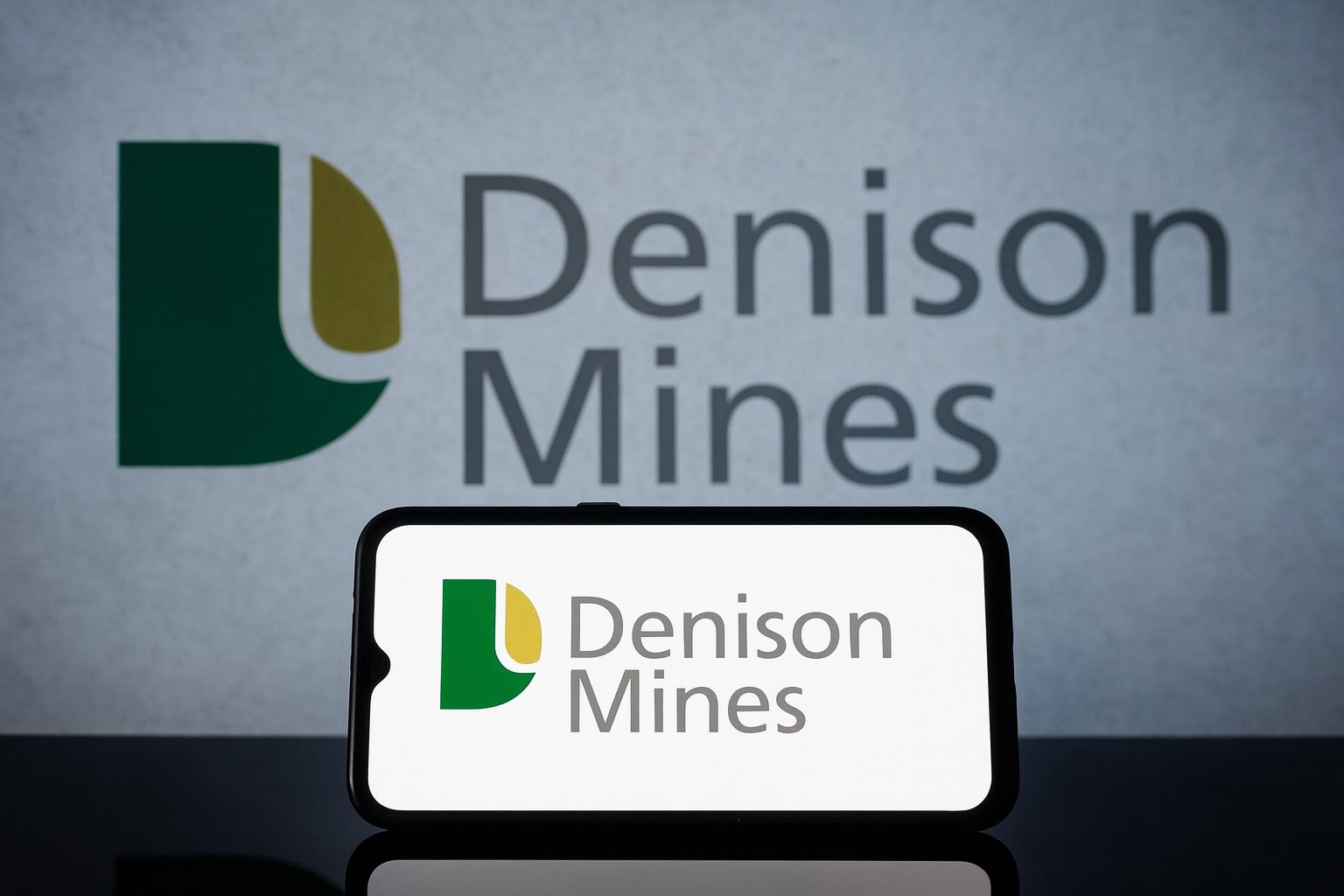- DNN Surges Over 100% YTD: Denison Mines Corp. (NYSE American: DNN, TSX: DML) has more than doubled in share price in 2025, recently touching multi-year highs (around $3.30 intraday) amid a uranium market boom [1]. After some profit-taking, the stock is hovering in the high-$2 range (≈$2.7–$3.0) heading into late October – still up over 100% year-to-date and vastly outperforming major indices [2].
- Uranium Prices at 14-Year High: A global “nuclear renaissance” has pushed uranium spot prices above $80 per pound – the highest since 2011 [3]. Dozens of countries plan to triple nuclear power capacity by 2050, boosting long-term uranium demand [4]. Meanwhile, supply remains tight (annual mine output ~130 Mlbs vs. ~180 Mlbs demand), exacerbated by Kazakhstan’s 10% production cuts from 2026 and disruptions in Niger and Russia [5]. The U.S. even invoked the Defense Production Act in October 2025 to bolster domestic uranium fuel supply [6].
- Flagship Project Nears Green Light: Denison’s Wheeler River uranium project in Saskatchewan cleared a major provincial permitting hurdle in 2025 and now awaits final federal license approval by December [7]. The Canadian Nuclear Safety Commission is holding final hearings in early December 2025 on Wheeler River’s Environmental Assessment and mine construction license. If approved, Denison aims to break ground in early 2026 and deliver first production by 2028 [8] – making Wheeler’s Phoenix deposit the first in-situ recovery uranium mine in Canada [9].
- Return to Production & High-Grade Finds: After 15 years with no output, Denison resumed uranium production in mid-2025 at its McClean Lake joint venture, marking its first “yellowcake” since 2008 [10]. CEO David Cates hailed the milestone as “a significant milestone” for Denison, heralding a return to active mining [11]. The company also unveiled stellar economics for its Midwest project (operating cost ~$11.70/lb U₃O₈, >80% IRR) [12] and discovered additional high-grade uranium at Wheeler River’s Gryphon deposit – developments that Cates says “de-risk” the pipeline by moving Denison closer to producer status [13].
- Fresh Funding and Rising Stakeholders: To fund its growth, Denison raised US$345 million in an upsized convertible notes offering in August [14], bolstering its balance sheet with ~$333 million net proceeds. National Bank subsequently hiked its price target for DNN to $4.57 (from $4.40), citing the strengthened balance sheet and confidence in Wheeler River’s outlook [15]. The company now sports a market capitalization around $2.6–$2.7 billion [16]. Institutional ownership has climbed to roughly 36–37% of the float (up from ~25% a year ago) as hedge funds and asset managers increased positions [17]. (For example, TD Asset Management boosted its stake by 4% in Q2, to ~$16.4 million worth of shares [18].)
- Analysts Bullish but Valuation Rich:All 5 analysts covering Denison rate the stock a “Buy” or “Outperform,” with a consensus 12-month price target of about $2.75 (slightly above current levels) [19]. Several analysts see far higher upside: Desjardins Capital recently reiterated a C$5.00 target (~US$3.65) on DNN, arguing that Denison’s high-grade assets and imminent project permits warrant a premium valuation [20]. Raymond James boosted its target to C$4.35 in October after Wheeler’s permit win [21]. However, experts caution that Denison’s torrid rally “already prices in a lot of good news” – any pullback in uranium prices or delays in project approvals could spark volatility [22]. Insiders have taken some profits as well (CEO David Cates sold 300,000 shares for ~C$1.18 million in late September at peak prices [23]), reflecting a degree of profit-taking after the huge run-up.
Stock Soars Amid Nuclear Revival
Denison Mines stock has been on a tear this year, riding a wave of optimism in the uranium sector. Shares of DNN have roughly doubled in 2025, making it one of the mining industry’s top performers [24]. After languishing near $1 per share last year, DNN began climbing steadily in mid-2025 as uranium prices rebounded. The rally accelerated this fall: the stock hit an intraday 52-week high of about $3.14 on October 13, before closing around $3.05 that day on heavy volume [25]. Even after a slight pullback to the high-$2s, Denison is still up over 100% year-to-date, vastly outpacing broader market indexes [26].
Several factors converged to fuel Denison’s surge. Chief among them is the uranium price boom. Spot uranium recently pushed above $80/lb for the first time since 2011, marking a 14-year high [27]. This price spike has been driven by a structural supply-demand mismatch and a resurgent outlook for nuclear energy. On the demand side, a worldwide push for carbon-free power and energy security has ignited what many are calling a “nuclear renaissance.” Over 30 countries – including major economies like the U.S., China, and India – plan to expand nuclear generation threefold by 2050 as part of their climate and energy strategies [28]. Even developments in the tech industry are contributing: huge investments by companies like Nvidia, Alibaba, and OpenAI into energy-hungry AI supercomputing centers have highlighted the need for reliable, carbon-free baseload power, boosting long-term confidence in nuclear demand [29].
Meanwhile, uranium supply remains constrained, which has amplified the price rally. Global mine output (around 130 million lbs U₃O₈ annually) falls far short of reactor requirements (~180 million lbs) [30]. The shortfall has forced utilities to draw down stockpiles and scramble for long-term supply contracts – often at premium prices. Recent geopolitical events have tightened the market further: Kazakhstan, the world’s top uranium producer, announced plans to cut output ~10% starting in 2026, Niger’s uranium mines have been disrupted by political unrest, and Western sanctions on Russia’s nuclear fuel industry (in response to the Ukraine conflict) have added uncertainty, since Russia handles a large share of global uranium processing [31]. In the U.S., the government went as far as invoking the Defense Production Act in October 2025 to support domestic uranium fuel production, underscoring strategic concerns about uranium supply [32]. All these factors – robust demand growth and constrained supply – have combined to send uranium prices soaring, which in turn has lifted the stocks of uranium producers and developers across the board.
Denison, as a junior uranium developer, offers outsized leverage to this uranium upswing. Many of its projects that were marginal at lower uranium prices now look highly attractive at $80+/lb. As analysts note, Denison provides “high leverage to uranium price increases,” since each dollar uptick in uranium significantly boosts the projected value of its high-grade reserves and development projects [33]. In practical terms, a mine that might barely break even at $45/lb uranium could generate robust profits at $80/lb. This leverage hasn’t been lost on investors – money has been flowing into uranium-focused equities like Denison on the expectation that sustained high uranium prices will turn these companies into big winners [34]. Indeed, some bullish forecasters are now even contemplating $90–$100/lb uranium by late 2025 if current trends persist [35], which would likely propel all uranium stocks higher.
Denison’s rally has also come amid a broader surge in uranium mining equities this year. The optimism for nuclear energy is sector-wide. For example, industry leader Cameco (NYSE: CCJ) recently hit multi-year highs around $83/share, and advanced developer NexGen Energy (NYSE: NXE) traded near $9/share – both far above their levels a year ago [36]. U.S.-focused producer Energy Fuels (NYSE: UUUU) saw its stock jump 23% in a single week in early October [37]. This broad rally provides important context: investors are not just betting on Denison in isolation, but on a sustained nuclear power revival driving up uranium demand (and prices) for years to come. That rising tide has lifted all boats in the uranium space, Denison included.
Advancing the Wheeler River Project
While macro trends lit the fuse under DNN stock, Denison’s own progress in 2025 has added fuel to the fire. This year has been a pivotal one for the company’s project pipeline, headlined by major strides at its flagship Wheeler River project in northern Saskatchewan. Wheeler River is the largest undeveloped uranium project in the infrastructure-rich eastern Athabasca Basin and is core to Denison’s future plans. The project consists of two high-grade deposits – Phoenix (which is being planned as an innovative in-situ recovery mine) and Gryphon (a follow-on conventional underground mine).
In August, Wheeler River cleared a crucial regulatory hurdle: the Province of Saskatchewan approved the project’s Environmental Assessment, marking the key provincial-level sign-off [38]. This approval was a milestone that de-risked the project significantly. Now the final step is federal permitting. The Canadian Nuclear Safety Commission (CNSC) commenced public licensing hearings for Wheeler River in October, and a concluding session is scheduled for December 8–12, 2025. Barring any surprises, regulators are expected to grant a Licence to Prepare and Construct for the Phoenix uranium mine shortly after those hearings. According to Denison, if a positive decision comes promptly, the company plans to break ground in early 2026 on the Phoenix ISR mine [39]. That timeline would keep Denison on track to achieve first production by 2028, which would transform the company from a developer into an actual uranium producer on a mid-tier scale [40].
The Wheeler River project has attracted attention not just for its scale but for its use of in-situ recovery (ISR) mining – a first in Canadian uranium mining. ISR is a lower-impact method that involves circulating a solution through the orebody to dissolve uranium underground and pump it to surface, rather than excavating or grinding ore. Phoenix’s deposit is uniquely well-suited for ISR thanks to its extremely high grades (ore zones averaging ~15–19% U₃O₈, many times the world average) and suitable geology. If successful, Phoenix could become one of the lowest-cost uranium mines globally. Denison’s 2023 feasibility study projected Phoenix’s operating costs to be in the bottom tier of the industry, potentially competitive with the world’s cheapest producers. The project’s advancement is being closely watched as a potential game-changer – demonstrating that ISR mining can unlock the Athabasca Basin’s rich deposits more economically and with less surface disturbance.
Apart from Wheeler River, Denison achieved something in 2025 it hadn’t in over 15 years – actual uranium production. In July, the company’s McClean Lake joint venture (22.5% Denison, majority-owned by Orano) in the Athabasca region produced its first batches of uranium ore since 2008. Using an innovative SABRE borehole mining technique, the operation extracted about 250 tonnes of very high-grade ore (averaging over 10% U₃O₈) from the McClean North deposit [41]. The ore was processed at the McClean Lake mill, yielding Denison’s first packaged yellowcake (uranium concentrate) in a decade and a half [42]. Though the initial output was modest, it marks a symbolic return to production. Denison will be able to book its share of production revenue in coming quarters – effectively the company’s first revenue from uranium sales in 15 years [43]. CEO David Cates called the achievement “a significant milestone” for the company, saying it heralds Denison’s return to active mining after a long hiatus [44]. This small-scale production also provided a valuable proof-of-concept for new mining techniques (like SABRE) that could potentially be applied to other shallow, high-grade deposits in the future.
Denison has also been busy enhancing the value of its project portfolio through engineering studies and exploration. In October, the company released an updated Preliminary Economic Assessment (PEA) for its Midwest project (Denison 25% interest, alongside partners Orano and OURD). The results were eye-catching: the study estimated operating costs of only about $11.70 per pound U₃O₈ and an after-tax internal rate of return (IRR) exceeding 80% (for Denison’s 25% share of the project) at uranium prices in the mid-$50s [45]. Even at a $50/lb uranium price, the project would be solidly profitable – indicating that Midwest could remain economic even if market prices soften from current highs [46]. Denison’s management highlighted the Midwest PEA as revealing a “hidden value” in the company’s asset base [47]. Since Wheeler River has understandably commanded most of the market’s attention, other assets like Midwest have arguably been undervalued by investors relative to their potential. The new study helps showcase that Denison has additional low-cost production opportunities waiting in the wings, beyond Wheeler River’s Phoenix and Gryphon.
On the exploration front, Denison continues to expand its resource base. The company drilled further at Wheeler River’s second deposit (Gryphon) this year and hit additional high-grade uranium intercepts [48], which should add to overall resource growth. Denison is also leveraging its expertise in the Athabasca Basin through strategic investments and partnerships. Notably, it increased its stake in Foremost Energy to about 19% in 2025 [49], and it entered a new exploration joint venture with Cosa Resources on some prospective ground in the region [50]. These moves aim to secure future pipeline projects in the uranium-rich district and demonstrate Denison’s intent to be a long-term player with multiple development nodes. In short, beyond just Wheeler River, the company is laying groundwork for a broader production pipeline to capitalize on the uranium upcycle.
Financial Strength and Market Activity
To support its ambitious development plans, Denison shored up its finances this year. In August, the company raised US$345 million through an upsized convertible note offering, a fundraising that was met with strong investor demand. The notes (due 2031) were upsized from an initial $300 million to $345 million, and Denison netted approximately $333 million in proceeds earmarked largely for Wheeler River’s advancement [51]. The financing significantly bolsters Denison’s balance sheet – as of Q3 2025 the company reported a healthy liquidity position (with a quick ratio around 3.7) after the raise [52]. Management indicated that the funds will go toward final engineering, early site works, and other pre-construction activities at Phoenix, as well as general corporate purposes.
While $345 million is a hefty war chest, fully building the Wheeler River project through to production will ultimately require additional capital (total project capex is expected to run several hundred million dollars). Denison’s CEO and CFO have been upfront that further financing will be needed for full construction of Phoenix and later Gryphon [53]. However, they have also emphasized flexibility in funding options – including potential strategic partnerships, offtake agreements, project financing debt, or additional equity raises – to minimize dilution and optimize the capital stack [54]. The recent strength in Denison’s share price is a double-edged sword in this regard: it gives the company a stronger currency (stock) for any future equity financing, but it also raises expectations that management will deploy capital prudently to avoid eroding shareholder value.
The good news for Denison is that the market has so far been very receptive to its story, enabling it to raise money relatively easily. The oversubscribed convertible note deal is one example. Another is that institutional investors have been steadily accumulating shares, reflecting growing confidence in Denison’s prospects. According to recent filings, institutions now hold roughly 36–37% of Denison’s outstanding shares [55] – up significantly from about 25% a year ago. A number of hedge funds and asset managers initiated or added to positions in 2025. For instance, TD Asset Management disclosed a 4.1% increase in its stake in Q2 (owning ~8.99 million shares worth $16.4 million) [56]. Other funds like Balyasny Asset Management, MMCAP International, and Connor Clark & Lunn Investment Management have also built new positions or expanded holdings this year [57] [58]. The roster of top shareholders now includes several uranium-focused investment funds and index ETFs (like those managed by ALPS and Van Eck), indicating that Denison is a key component of many uranium investment strategies [59] [60].
It’s also worth noting that trading activity in DNN has been elevated, suggesting increased interest from retail traders and option market participants. In mid-October, for example, one trading day saw around 36,000 call option contracts trade on DNN – roughly 3.5 times the typical volume [61]. Such spikes in options activity often point to speculative bets on further upside. Denison’s average daily share volume has also climbed well above historical norms in recent months, as more market participants seek exposure to uranium via well-known tickers like DNN.
Despite the overwhelmingly positive momentum, insiders have not been big buyers of the stock on the way up – instead, some took the opportunity to sell shares. Company filings show that in late September, as DNN was near its highs, CEO David Cates sold 300,000 shares (about 14% of his direct holdings) at prices around C$3.92 (~US$2.90), for proceeds of roughly C$1.18 million [62]. Another executive (VP Amanda Willett) sold 95,000 shares around the same time [63]. These sales represent only a small portion of total shares (insiders as a group own well under 1% of Denison’s stock [64]), and such profit-taking is not unusual after a big run-up. Still, it’s a reminder that insiders recognize the stock’s strength and have chosen to realize some gains. The transactions were disclosed through SEDI (the Canadian insider reporting system) and did not appear to spook the market, given the stock has held up since. Investors will be watching insider activity going forward for any signs of confidence or concern from those closest to the company.
Wall Street Commentary and Outlook
Sell-side analysts remain broadly bullish on Denison Mines, even after the stock’s huge YTD climb. All five brokerages that officially cover DNN maintain either “Buy” or “Outperform” ratings at present [65]. The consensus 12-month price target is approximately $2.75 per share [66], which is only slightly above the latest trading levels (high-$2 range). However, several analysts argue this target is likely to be revised upward given the strong uranium backdrop and Denison’s project progress. In fact, many firms have been hiking their targets through 2025 as the story improved. For example, Desjardins Capital Markets has one of the highest profiles on the stock with a target of C$5.00 (≈US$3.65) – reiterated after Denison’s provincial permit win – on the view that Denison’s high-grade resources and imminent construction approvals justify a premium valuation relative to peers [67]. Raymond James also bumped its target to C$4.35 (from C$4.05) in October [68], citing the de-risking of Wheeler River following environmental approval. And as noted, National Bank raised its target to $4.57 in September after the company’s successful financing, seeing an improved balance sheet and path to a final investment decision on Phoenix as catalysts [69].
Brokerage analysts often couch their optimism with some caveats, acknowledging that a lot of good news is already reflected in Denison’s share price. At its current ~$2.8–$2.9, DNN is trading near multi-year highs and at a market capitalization of roughly $2.6–$2.7 billion [70]. For a company that is not yet producing significant revenue and still in a development stage, that valuation is considered steep by traditional metrics. Denison remains unprofitable (trailing P/E is negative, given no earnings) and continues to report net losses each quarter while it invests in project development [71]. Some independent research notes have flagged Denison’s weak current financials and high valuation multiples as risk factors [72]. In other words, the stock is pricing in a substantial portion of anticipated future success – from high uranium prices to timely Wheeler River production – leaving limited margin for error in execution. As one market observer commented, Denison’s 2025 rise “already prices in the good news” to a large extent [73]. The bullish thesis will need to be validated by the company hitting key milestones on schedule (permit approvals, construction start, etc.) and by uranium prices staying elevated. Any material setback – such as a delay in licensing or a pullback in uranium prices – could lead to a sharp correction in such a momentum-driven stock [74].
That said, many analysts and investors believe the current nuclear cycle is still in its early innings, which could mean further upside for uranium equities like Denison. Some medium-term forecasts underscore this optimism. For instance, a recent trend analysis projected that if uranium prices remain strong and Denison executes as planned, DNN shares could rise another 30–45% by early 2026 – which would imply a stock price in the mid-$3 to low-$4 range [75]. A compilation of Wall Street estimates similarly shows a median price around $3.75 for 2026, roughly 25–30% above today’s level [76]. These projections effectively assume that the positive momentum continues: robust uranium pricing, Wheeler River staying on track, and growing investor appetite for uranium assets. Indeed, many uranium market experts do see room for further uranium price gains. Industry strategists note that utility companies still need to secure a large volume of uranium in coming years, and some have even suggested that uranium could hit $100/lb in the not-too-distant future if supply challenges persist [77]. Such a scenario would likely be a tide that lifts all boats in the uranium mining sector – Denison included.
As for broader market sentiment, the recent achievements by Denison have undoubtedly increased investor confidence. Milestones like restarting production at McClean Lake and nearing final approval at Wheeler River have materially de-risked Denison’s story, according to both the company and outside analysts [78] [79]. Each successful step – be it a permit, a field test of a new mining method, or a financing – reduces uncertainty about the company’s ability to eventually become a profitable producer. This narrative of transformation from a pure explorer to an emerging producer has attracted new institutional investors and helped justify a richer valuation multiple for the stock [80] [81]. “The transformation has convinced many that [the company] is transitioning into a producer,” noted one market report on Denison’s evolution, as new long-term shareholders came on board [82].
Conclusion
Denison Mines has surfed a perfect wave of strong uranium markets and project breakthroughs to become one of 2025’s standout mining stocks. Its share price has skyrocketed alongside uranium prices, and the company’s imminent entry into construction and production marks a new chapter in its 70-year history. Supportive macro tailwinds – from a global nuclear energy push to geopolitical supply worries – provide a favorable backdrop that could continue to benefit Denison and its peers. Over the next 6–12 months, investors will be watching for final regulatory approvals at Wheeler River (expected around year-end), the commencement of mine development in 2026, and any evidence that uranium’s bull run is either accelerating or cooling off.
The medium-term outlook for DNN remains optimistic yet contingent on execution. Analysts generally see further upside, with price targets in the $3–4+ range based on successful project delivery and sustained uranium strength [83] [84]. At the same time, the stock’s current valuation leaves little room for disappointment. A company that’s still pre-revenue is being valued in the billions, so Denison will need to deliver on the promise of Wheeler River and continue riding the uranium uptrend to grow into its valuation. For retail investors and general observers, Denison Mines encapsulates the renewed excitement around nuclear energy – a junior miner transforming into a producer just as the world re-embraces the atom. The coming year will be crucial in determining whether this high-flying uranium stock’s rally is just the beginning of an even bigger run, or if it has already hit its peak optimism. As the nuclear renaissance unfolds, Denison Mines is firmly in the spotlight, with a bullish narrative tempered by the realities of project development and market volatility.
Sources: Denison Mines Corp. official releases; TS² Financial News [85] [86] [87]; MarketBeat [88] [89]; AInvest News [90]; CoinCentral [91] [92].
References
1. ts2.tech, 2. ts2.tech, 3. ts2.tech, 4. ts2.tech, 5. ts2.tech, 6. ts2.tech, 7. ts2.tech, 8. ts2.tech, 9. ts2.tech, 10. ts2.tech, 11. ts2.tech, 12. ts2.tech, 13. ts2.tech, 14. www.ainvest.com, 15. www.ainvest.com, 16. www.marketbeat.com, 17. www.marketbeat.com, 18. www.marketbeat.com, 19. www.marketbeat.com, 20. ts2.tech, 21. ts2.tech, 22. ts2.tech, 23. simplywall.st, 24. ts2.tech, 25. ts2.tech, 26. ts2.tech, 27. ts2.tech, 28. ts2.tech, 29. coincentral.com, 30. ts2.tech, 31. ts2.tech, 32. ts2.tech, 33. ts2.tech, 34. ts2.tech, 35. ts2.tech, 36. ts2.tech, 37. ts2.tech, 38. ts2.tech, 39. ts2.tech, 40. ts2.tech, 41. ts2.tech, 42. ts2.tech, 43. ts2.tech, 44. ts2.tech, 45. ts2.tech, 46. ts2.tech, 47. ts2.tech, 48. ts2.tech, 49. ts2.tech, 50. ts2.tech, 51. www.ainvest.com, 52. ts2.tech, 53. ts2.tech, 54. ts2.tech, 55. www.marketbeat.com, 56. www.marketbeat.com, 57. coincentral.com, 58. coincentral.com, 59. simplywall.st, 60. simplywall.st, 61. ts2.tech, 62. simplywall.st, 63. simplywall.st, 64. simplywall.st, 65. www.marketbeat.com, 66. www.marketbeat.com, 67. ts2.tech, 68. ts2.tech, 69. www.ainvest.com, 70. www.marketbeat.com, 71. ts2.tech, 72. ts2.tech, 73. ts2.tech, 74. ts2.tech, 75. ts2.tech, 76. ts2.tech, 77. ts2.tech, 78. ts2.tech, 79. ts2.tech, 80. ts2.tech, 81. ts2.tech, 82. ts2.tech, 83. ts2.tech, 84. www.ainvest.com, 85. ts2.tech, 86. ts2.tech, 87. ts2.tech, 88. www.marketbeat.com, 89. www.marketbeat.com, 90. www.ainvest.com, 91. coincentral.com, 92. coincentral.com








